|
COVER STORY | IN
THE NEWS | STAGE
MATTERS February 9, 2006
by HEIDI WALTERS 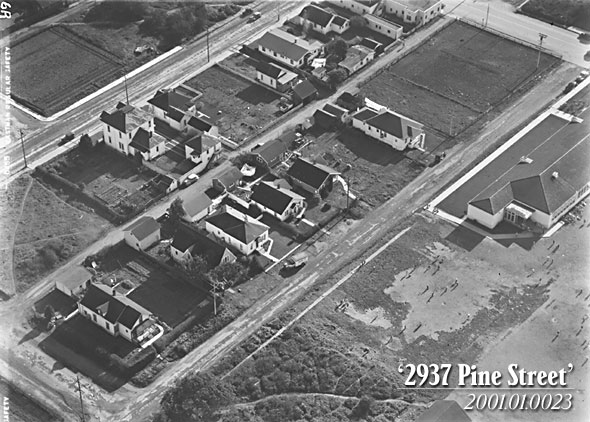
'2937 Pine Street'catalog number 2001.01.0023
Then he splashed down, went home, grew up, got a job, maybe got married and had kids, or went to jail, or both, or died young. Or maybe he lived and today he's a leader in the Eureka community, getting ready to turn the business over to an offspring. Maybe he hiked on out of here after a stint in the mills, or at Humboldt State, and hasn't come back. Who knows? All we know is that on Dec. 9 in 1946 the sun came out after the usual rain and a boy roaming the schoolyard -- where clusters of girls in dresses played jacks on the sidewalk and other boys played ball -- saw that glinting great big puddle and jumped. That was kind of how it was for Merle Shuster, too, that Monday in 1946. The 24-year-old was at work at the Photo Specialty Shop in Eureka when the sun finally came out. "Boss, the sun's out," you can imagine he said. "Go on, get outta here," his lenient boss would have answered. He was used to Shuster's sudden flights. And so Shuster called the airport to find a pilot -- probably Paul Fleming. Then he jumped into the skies above Humboldt County for a very long lunch hour.
'3rd, 4th, E & F'catalog number 2001.01.0032
Shuster mostly used a hand-held "F-8" camera that took big 5" by 7" negatives. Those aerials can swoop you right down into, say, 1952 downtown Eureka on a sunny afternoon. You can see people walking around down there, accompanied by their shadows, and you feel that if you just shouted hello at that lady in the dress, nice coat and hat walking briskly along F Street between 3rd and 4th, she would look up at the sky and shout hello back. It's a little disconcerting, like Peeping Tom time travel. The buildings look scrubbed, crisp. The waterfront, a little less scrubbed: logs corralled in the water drift into geometrical formations, rough workhorse boats collect at the edges or wait in narrow chutes. In several photos the old courthouse in Eureka still grandly stands, gleaming like a white cake on a big platter of groomed land, looking too solid and important to be taken down even by planetary fits. In another, of a rural Eureka neighborhood, you can count the white chickens pecking at the earth and see a man in a white T-shirt standing at the open window of his house looking out. For Shuster, the flights were for work. "I had three children to raise," he says. "And in those days, we didn't have Saturdays off. I went to church on Sundays." So in addition to his regular job at the photo shop he did freelance photography assignments: weddings, accident photos for Brown Brothers Adjusters and aerial shots for industrial clients and developers. "Back then, right after the war, there were hundreds of lumber mills here," Shuster says. "So there were lots of jobs for me. I had my commercial license to sell pictures, and I had my own darkroom. Hammond Lumber Company was a big name, for instance, and they had their logs stored at Big Lagoon. Once a year they would have me take big, overlapping pictures of their big log ponds so they could count their logs." For those he'd shoot verticals through the bottom of the plane. The collection, however, contains hundreds of detail-rich oblique aerials that Shuster took hanging over the side of the plane. "On my way to and from these jobs I'd take pictures of things I thought were nice," he explains. He didn't always shoot in fair weather. In the early 1950s, developer Chet Spiering's master-planned community, Sunny Brae, was taking shape outside Arcata. "And Chet Spiering, he wanted photos no matter the weather, or if it got dark," says Shuster. For those jobs he called pilot Al Camili. "There were some who may not want to go up when the weather was bad, but Al Camili would go." Planners have long known about Shuster's photos and have used them for reference. But not until late last month did Shuster's aerial photographs become available for viewing, for free, to the world. HSU has put them on the web. Now you, too, can dive through the sharp, black-and-white bubble of time into early Humboldt County. Just go to http://library.humboldt.edu/humco/holdings/shuster.htm. You can narrow the search down by adding keywords, such as "Arcata mills" or "Eureka waterfront." Also, from Feb. 14 to March 13, the HSU Library is hosting the first showing of prints of Shuster's aerials. Arcata-based fine-art photographer Joseph Wilhelm put the exhibit together, wading intrepidly through the 2,000-plus negatives to select and print 24 of them.
'California Barrel Factory'catalog number 2001.01.0216 LOCAL HISTORIAN JERRY ROHDE IS planning to use a dozen or so of Shuster's old aerials in the geographical history he's writing of Humboldt County, including one of California Barrel Company's operations. Cal-Barrel, cutting mostly spruce, was the biggest employer in Arcata back in the 1940s. "There's a real tension in Merle's photos, where you have the natural world being affected by the industrial world," says Rohde. "And a photo like this, of the Cal-Barrel plant, you can see the beauty in it, the logs all lined up. I think your emotions get kind of complicated when you look at this. There's some sense of destruction. You know that somebody had to cut down 40 acres of forest so that Merle could fly over and take a picture of it. And if I saw the cut forest, I'd be saddened. But Merle took industrial activities and gave them the dignity that I think is there." He compares Shuster's aerials to the works of great land photographers, especially O. Winston Link, whose photos of America's last steam trains also show the rich artistry in industry. "But [Link] maybe took hours to set up a photo, whereas Merle was just zipping along with the side door off the plane. I think he had a gift for it."
'Arcata Mills'catalog number 2001.01.2356 "THE LATE 1940S AND EARLY 1950S, that was one of the most significant periods of change in Humboldt County," says Rohde. "The Second World War was over, and there was this huge housing boom nationwide. One of the effects up here was to jump-start the timber industry. And instead of cutting redwood, as in the past, they started cutting Douglas fir -- they finally decided [it] was a good building material, especially for framing houses. And so there was this whole new market for the area, and a lot of these mills got started, family-type operations. There were about 350 mills in the county by about 1950. There were 50 mills in the Arcata area alone." Rohde has dubbed one photo "The Valley of the Many Smokes." It shows drifting plumes of smoke from eight "teepee" burners -- conical ovens used to burn wastewood -- near Arcata. "That's a powerful image," Rohde says. "People think of Arcata as this radical college town, but in the 1940s it was a big timber town and it had all of these mills. They say you couldn't hang your clothes out to dry because they'd pick up the ash."
'Traveler's Rest Motel'catalog number 2001.01.0616 IN 1947, SHUSTER MADE FOUR SEPARATE passes over the Traveler's Rest Motel Court ("100% Electric"), north of Eureka where Highway 101 crosses the slough. The first one's far away, the next two closer. Four months later, "he finally got it right," says Rohde. "You can really see the detail." There's the big white structure by itself in a sea of fields, and in its large inner courtyard is one lone, two-tone automobile. "And you can really read into it: You know, the alienation of American travel. This gives me the same feeling as an Edward Hopper painting. There's a sense of isolation, and this kind of melancholy." Historically speaking, Humboldt County had undergone a transportation shift by that time. "Fifty years before Merle was taking his photos, it was mostly travel by stagecoach or horseback," says Rohde. "And you had to cross by ferries, and so a lot of times a small community would develop at a ferry crossing called a 'stopping place,' often just an oversize ranch house. I think it was a more communal gathering." But the Traveler's Rest Motel is "fortress-like, almost like you're there to be insulated, to be protected."
|

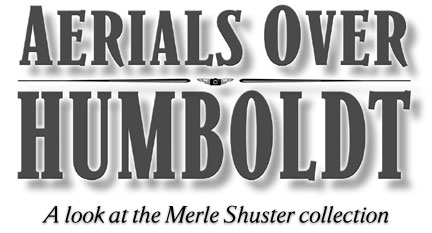
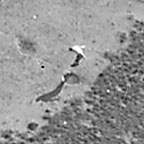 THERE HE IS, SUSPENDED IN BLACK-AND-WHITE:
ARMS flung back, legs piked straight from the hips, torso kipped
forward at the waist, head down and eyes no doubt sparkling with
glee at the awaiting puddle inches from his descending toes.
A low-angle, late-afternoon winter sun casts a perfect shadow
that mimics the boy's perfect jump, and the immediacy and spontaneity
of the moment catches in your throat when you realize that that
boy in the photo jumped, hovered and eye-sparkled in the schoolyard
60 years ago.
THERE HE IS, SUSPENDED IN BLACK-AND-WHITE:
ARMS flung back, legs piked straight from the hips, torso kipped
forward at the waist, head down and eyes no doubt sparkling with
glee at the awaiting puddle inches from his descending toes.
A low-angle, late-afternoon winter sun casts a perfect shadow
that mimics the boy's perfect jump, and the immediacy and spontaneity
of the moment catches in your throat when you realize that that
boy in the photo jumped, hovered and eye-sparkled in the schoolyard
60 years ago.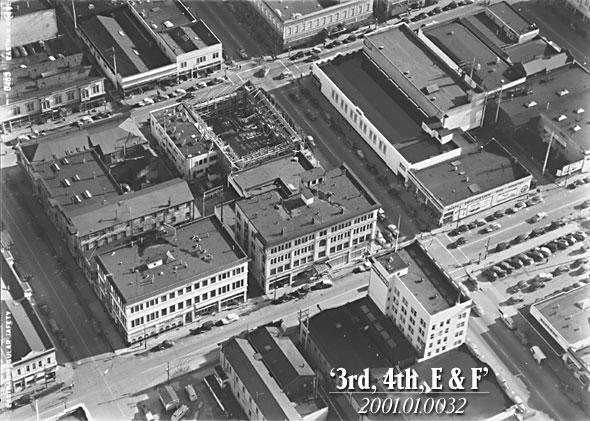
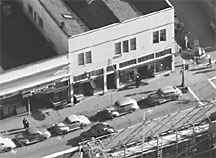 A FEW YEARS AGO,
MERLE SHUSTER DONATED AN ARMFUL of flowery cardboard photo-saver
boxes to the Humboldt Room at Humboldt State University. The
boxes contained 2,463 negatives and some prints of aerial photographs
Shuster took of the Humboldt Bay region between the mid-1940s
and early 1960s.
A FEW YEARS AGO,
MERLE SHUSTER DONATED AN ARMFUL of flowery cardboard photo-saver
boxes to the Humboldt Room at Humboldt State University. The
boxes contained 2,463 negatives and some prints of aerial photographs
Shuster took of the Humboldt Bay region between the mid-1940s
and early 1960s.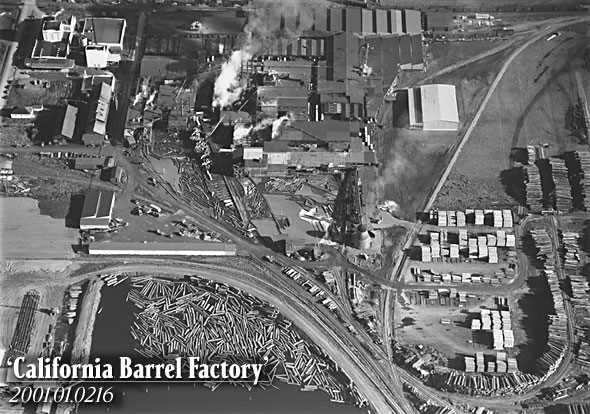
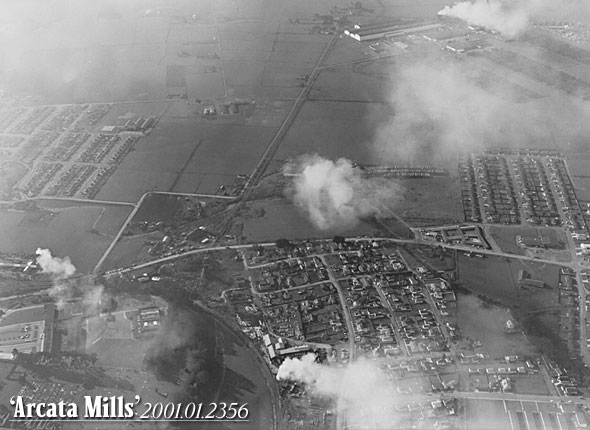
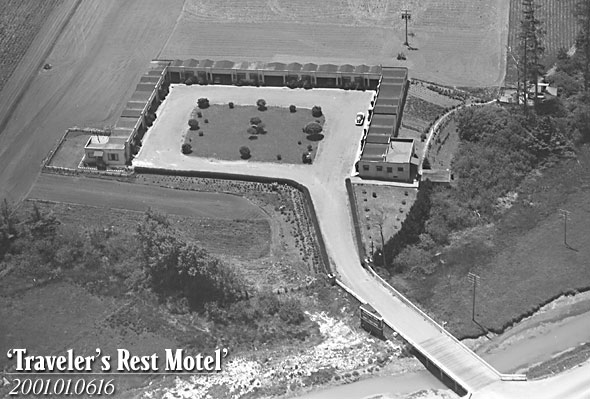
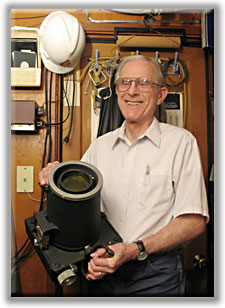 Merle's
story
Merle's
story